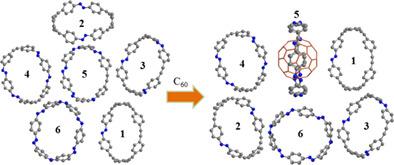当前位置:
X-MOL 学术
›
J. Comput. Chem.
›
论文详情
Our official English website, www.x-mol.net, welcomes your feedback! (Note: you will need to create a separate account there.)
Composition-selective full inclusion host–guest interaction of azobenzene-containing photoresponsive nanoring with fullerene C60
Journal of Computational Chemistry ( IF 3 ) Pub Date : 2022-05-29 , DOI: 10.1002/jcc.26931 Kun Yuan 1 , Mengyang Li 2 , Yaoxiao Zhao 2, 3 , Yanzhi Liu 1 , Xiang Zhao 2
Journal of Computational Chemistry ( IF 3 ) Pub Date : 2022-05-29 , DOI: 10.1002/jcc.26931 Kun Yuan 1 , Mengyang Li 2 , Yaoxiao Zhao 2, 3 , Yanzhi Liu 1 , Xiang Zhao 2
Affiliation

|
By means of density functional theory calculations, the encapsulation capabilities of a series of azobenzen-containing photoresponsive nanoring hosts (labeled as host 1, 2, 3, 4, 5 and 6 according to the number of the azo unit, respectively) for fullerene C60 were surveyed. Interestingly and abnormally, it is found that the host 5, of which the diameter is only 1.218 nm, can form stable full inclusion complex with C60. However, irrespective of their cavity sizes (11.98 ~ 12.94 Å) of the hosts, the structures 1 ~ 4 and 6 were all disable to form inclusion complex with C60. In this paper, the group-number-composition-selective full inclusion host-guest interaction of the azobenzene-containing nanorings with fullerene C60 is firstly presented. The calculated interaction energies, together with the detection and visualization of the weak interaction regions, provided evidences for the host-guest binding based on relative strong repulsion interaction in the full inclusion complex. Analysis on the frontier orbital feature of the host-guest systems suggests that under the electron excited condition, the chemical activity may be transferred from host 5 to guest C60 by formation of the floating host-guest complex, and the chemical reactivity of the host 5 can be passivated via formation of the full inclusion host-guest complex. Additionally, UV–vis–NIR and 1H NMR spectra of the hosts before and after the formations of the complexes have been simulated and discussed qualitatively, which may be helpful for further experimental investigations in future.
中文翻译:

含偶氮苯的光响应纳米环与富勒烯 C60 的成分选择性全包合主客体相互作用
通过密度泛函理论计算,一系列含偶氮苯的光响应纳米环主体(根据偶氮单元的数量分别标记为主体1、2、3、4、5和6 )对富勒烯C的包封能力对60人进行了调查。有趣且异常地发现,直径仅为1.218 nm的主体5可以与C 60形成稳定的全包合物。然而,无论主体的空腔大小(11.98 ~ 12.94 Å)如何,结构1 ~ 4 和6均不能与C 60形成包合物。本文首次提出了含偶氮苯纳米环与富勒烯C 60的基团数组成选择性全包合主客体相互作用。计算的相互作用能,以及弱相互作用区域的检测和可视化,为基于全包合物中相对强排斥相互作用的主客体结合提供了证据。对主客体系统前沿轨道特征的分析表明,在电子激发条件下,通过形成浮动的主客体复合物,以及主体的化学反应性,化学活性可能从主体5转移到客体C 60 。5可以通过形成完全包含的主客体复合物来钝化。此外,对配合物形成前后主体的紫外-可见-近红外和1 H NMR 光谱进行了模拟和定性讨论,这可能有助于未来的进一步实验研究。
更新日期:2022-05-29
中文翻译:

含偶氮苯的光响应纳米环与富勒烯 C60 的成分选择性全包合主客体相互作用
通过密度泛函理论计算,一系列含偶氮苯的光响应纳米环主体(根据偶氮单元的数量分别标记为主体1、2、3、4、5和6 )对富勒烯C的包封能力对60人进行了调查。有趣且异常地发现,直径仅为1.218 nm的主体5可以与C 60形成稳定的全包合物。然而,无论主体的空腔大小(11.98 ~ 12.94 Å)如何,结构1 ~ 4 和6均不能与C 60形成包合物。本文首次提出了含偶氮苯纳米环与富勒烯C 60的基团数组成选择性全包合主客体相互作用。计算的相互作用能,以及弱相互作用区域的检测和可视化,为基于全包合物中相对强排斥相互作用的主客体结合提供了证据。对主客体系统前沿轨道特征的分析表明,在电子激发条件下,通过形成浮动的主客体复合物,以及主体的化学反应性,化学活性可能从主体5转移到客体C 60 。5可以通过形成完全包含的主客体复合物来钝化。此外,对配合物形成前后主体的紫外-可见-近红外和1 H NMR 光谱进行了模拟和定性讨论,这可能有助于未来的进一步实验研究。



























 京公网安备 11010802027423号
京公网安备 11010802027423号